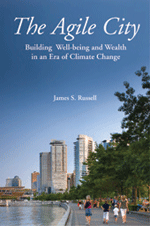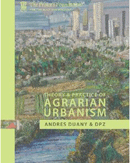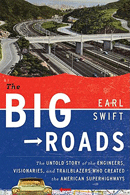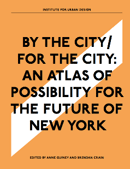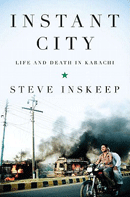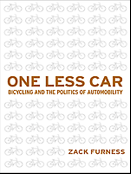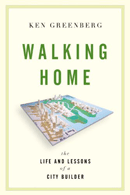Top 10 Books - 2012
Planetizen’s tenth annual list of the best books in urban planning, design and development ranges from a crowdsourced compendium of ideas for upgrading New York City's built environment to a personal report from the streets of Karachi.
Planetizen is pleased to release its tenth annual list of the ten best books of the year in urban planning, design and development. The Planetizen editorial staff based its 2012 list on a number of criteria, including editorial reviews, popularity, number of references, sales figures, recommendations from experts and the book's potential impact on the urban planning, development and design professions. This year is dominated by "big picture" books, with a number of prominent critics and commentators zooming way out to look at how cities can achieve sustainability, affordability and economic viability. Ed Glaeser's Triumph of the City was impossible to miss this year, whether you agreed with his conclusions or not. But you'll also find some beautiful coffee table books, a political history of bicycling and a detailed plan for incorporating agriculture into urbanism. We present our list in alphabetical order, and are not assigning rank. And now, on to the list!
The Agile City: Building Well-Being and Wealth in an Era of Climate Change
By James S. Russell Island Press, 312 pages
In his first book, architecture critic James S. Russell sets criticism aside to present his big picture vision for urban success. He makes the economic case for inventing and refining hundreds or thousands of small tactics and technologies to combat climate change rather than placing our bets largely on a few speculative big technologies (hence, the "agile" city). The global warming debate often regards energy efficiency almost condescendingly, as something nice to do but of marginal usefulness. Russell counters this logic strongly, offering many wealth generating strategies that can be implemented to incrementally reduce our environmental impact while improving our quality of life and ultimately ensuring the lasting competitiveness of our cities. The book analyzes the last few decades of consumption-powered economic growth that has produced America's current economic arthritis, and proposes a more networked approach that links land use, economic development, energy and transportation closer together.
Garden Cities: Theory & Practice of Agrarian Urbanism
By Andrés Duany and Duany Plater-Zyberk and Company The Prince's Foundation for the Built Environment, 99 pages
Andrés Duany is often, and aptly, described as a force of nature. In this book, he's taken nature a step further, creating a model as audacious as Ebenezer Howard's Garden Cities of To-Morrow for incorporating agriculture into all facets of the urban fabric. Like with the urban transect concept he pioneered, this small book outlines ways that growing farming can happen at all levels, from an apartment window-box to a small 1-2 acre farm. As architects continue to bang out "green building" concepts where trees perch from shiny skyscrapers, Duany's proposals are refreshingly practical while not being any less bold and visionary.
The Big Roads: The Untold Story of the Engineers, Visionaries, and Trailblazers Who Created the American Superhighways
By Earl Swif Houghton Mifflin Harcourt, 384 pages
Not unlike last year's favorite Interstate 69 by Matt Dellinger, The Big Roads tells the story of the Interstate Highway System. Swift, however, is more in awe of the great breadth and imagination behind the feat. This is the kind of book we love to feature: a tale that brings depth and insight to a topic while also reading like a well-written novel. Swift essentially focuses on three men who were essential to the creation of the system, including civil engineer Thomas Harris "Chief" MacDonald, who argued in the 1920s that good roads are a human right. Swift doesn't neglect the present day however, recognizing that the unstoppable expansion of the past has saddled the U.S. with an infrastructure it can't afford.
By the City, For the City: An Atlas of Possibility for the Future of New York
By The Institute for Urban Design Multi-Story Books, 352 Pages
You can't buy this book on Amazon, or from Powells. This unique book is a collection of "schemes & dreams"; ideas from everyday people around the world about how New York City should evolve and grow realized by designers and architects. Kitchen sink ideas include everything from planters hung from the back of billboards to turning unused space in Staten Island ferries into floating museums (with cocktails, of course). The Institute for Urban Design has done a wonderful job of presenting these out-of-the-box ideas in a way that can inspire tactical urbanists and professional planners to think differently.
For the Love of Cities: The Love Affair Between People and their Places
By Peter Kageyama Creative Cities Productions, 242 pages
In the introduction to this fast moving 215-page book, Kageyama asserts that when considering the improvement of cities, the pursuit of livability, no matter how it is defined or measured, is not enough. He writes: "Livable is good-it's a fine aspiration that we have yet to achieve on any large scale. But I think we can do better. Instead of merely livable, I think we need to start thinking about how we make our cities more lovable. When we love something, we cherish it; we protect it; we do extraordinary things for it." While the book covers a range of relevant topics- the importance of walkability, openness, and increasing public engagement through social media-the book focuses mostly on "co-creators" and how they make cities more lovable. According to Kageyama successful cities consistently attract and retain an evolving community of co-creators – those committed entrepreneurs, artists, performers, organizers, and concerned citizens-who "make things, and make things happen."
Instant City: Life and Death in Karachi
By Steve Inskeep The Penguin Press HC, 304 pages
Steve Inskeep, who's voice is instantly familiar to any NPR listener, brings us this fascinating look at the "instant city" of Karachi, Pakistan. He calls it an "instant city" because it, like many urban areas around the world, has seen an epic migration from the country to the city, going from half a million in the 40s to 13 million today. Opening up the book with a bombing in Karachi, Inskeep peels away at the traditional reasons of why the bombing occurred, like a terrorist attack, and finds more theories that point to the areas valuable real estate. The book delves deeply into the city's urban planning issues like casino developments, housing projects, squatting, road building, and land use squabbles, not to mention the deeper divisions along religious and ethnic lines. Throughout, Inskeep delivers a thoughtful and powerful story mixed with an analytical eye at the built environment.
One Less Car: Bicycling and the Politics of Automobility
By Zack Furness Temple University Press, 344 pages
Out of the pile of bicycle-centric books that landed in our office, One Less Car by Zack Furness jumped to the top. Furness, a cultural studies professor at Columbia, looks at what it means to be part of the 1% - in this case, the percentage of the total U.S. population that ride bicycles for transportation. The book is an engaging look at the cultural and political significance of the bicycle through history, exploring the little known story of groups like Ciclisti Rosso, the "Red Cyclists", a 1912 socialist group that were antecedents to today's Critical Mass. Furness looks at activist movements that have popped up across the country, whether it is DIY bike movements or government supported awareness campaigns. The author occasionally indulges a little too much in academic jargon, but on the whole he presents a comprehensive and informative look at the meaning behind the fixies, cruisers and road bikes of today.
Pocket Neighborhoods: Creating Small-Scale Community in a Large-Scale World
by Ross Chapin Taunton Press, 224 pages
A coffee table book with a mission, Pocket Neighborhoodspresents a focused look at a unique sort of development which the author defines as "clusters of homes gathered around a landscaped common area." These "pocket neighborhoods" are a traditional model that was lost in the suburban shift, and today is spurring a new movement towards increased togetherness and a sense of community. Chapin writes with an approachability that invites laypeople in, but also includes design tips and lots of lovely pictures to inspire professionals. He brings his own expertise in designing pocket neighborhoods to illustrate the lessons they've learned through trial and error. Chapin's narrow focus on this under-explored method of creating community makes this an essential read.
Triumph of the City: How Our Greatest Invention Makes Us Richer, Smarter, Greener, Healthier, and Happier
By Edward Glaeser The Penguin Press HC, 352 Pages
In a previous era, Harvard professor Ed Glaeser, bedecked in his trademark three-piece suit, might have been the one of the technocrats out there with his slide rule and transit, "scientifically" deciding just how much of a neighborhood to knock down. But, today, urban planning's very own Don Draper has put quantitative analysis to a far more humane use. If Jane Jacobs wrote from the heart, Glaeser writes decidedly from the head. But he reaches much the same conclusions as Jacobs did: cities are wonderful and, most importantly for Glaeser, cities create value. Much of the data analysis--not to mention the poetic connections between Renaissance art, the Golden Age of Athens, and call centers in Bangalore--is intuitive to contemporary progressive urbanists. True to his conservative manner, Glaeser does not call for radical re-visioning of cities. His arguments imply that everything from historic preservation to urban agriculture to congestion pricing can be valuable only insofar as they support a city's ability to nurture ideas and increase prosperity.
Walking Home: The Life and Lessons of a City Builder
By Ken Greenberg Random House Canada, 400 pages
Walking Home is a personal, compelling and persuasive argument for more enlightened city-building, made all the more convincing by the Toronto-based author's 30 years of international experience as an urban designer and architect. At once a memoir, a history of North American urban planning and a manifesto for a more sustainable and humane urban future, Walking Home articulates the urgent need for change while providing his colleagues and interested laypersons alike practical and entertaining guidance for bringing it about.Greenberg argues that, if we are to continue to live in large cities in an era of high energy costs and climate change, then we need to "reclaim the promise of the city" by making our cities places of diversity and adaptability, of density and vibrant public spaces, where nature and the city are integrated, and where we can leave our cars behind and walk among -- and get to know -- our neighbors.
Read original here
